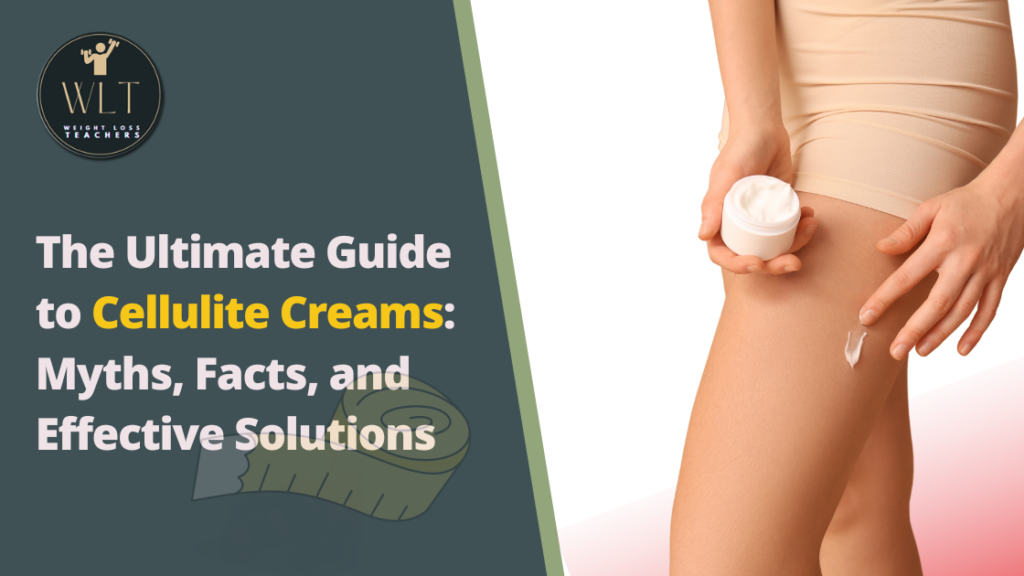
The Ultimate Guide to Cellulite Creams: Myths, Facts, and Effective Solutions

Cellulite is a common cosmetic concern affecting millions of people worldwide. Although it poses no health risks, it can significantly impact self-confidence and body image. Many individuals seek solutions to reduce the appearance of cellulite, and cellulite creams have gained popularity as a potential remedy.
Table of Contents
Cellulite Creams
In this comprehensive guide, we will delve into the world of cellulite creams, separating myths from facts, exploring their ingredients, analyzing their effectiveness, and providing practical tips for achieving smoother-looking skin. Whether you’re new to cellulite creams or seeking more information, this article will serve as a valuable resource.
Section 1: Understanding Cellulite: Causes and Characteristics

Cellulite affects a significant portion of the population, causing dimpled skin primarily on the buttocks and thighs. Contrary to popular belief, cellulite is not solely a result of weight gain or an indicator of poor health. It is a complex condition influenced by various factors.
Genetics plays a crucial role in determining an individual’s susceptibility to cellulite. Some people may have a genetic predisposition to weaker connective tissue or a higher proportion of fat cells in specific areas, making them more prone to developing cellulite.
Hormonal factors also contribute to the development of cellulite. Hormones like estrogen and insulin can affect the metabolism, blood circulation, and fat storage, potentially leading to cellulite formation.
Lifestyle choices can significantly impact the appearance of cellulite. A diet high in processed foods, excess sugar, and unhealthy fats can contribute to weight gain and the accumulation of fat cells. Lack of physical activity, smoking, and high-stress levels can also exacerbate the appearance of cellulite.
Additionally, age-related changes in the skin, such as decreased collagen and elastin production, reduced blood flow, and loss of skin thickness, can contribute to the visibility of cellulite.
Understanding the causes of cellulite provides insight into how cellulite creams work. While creams cannot alter genetic factors or completely eliminate cellulite, they may help improve the appearance and texture of the skin.
Section 2: Cellulite Creams: An Overview

Cellulite creams are topical products formulated to target cellulite and improve the overall appearance of the skin. They are available in various forms, such as gels, lotions, serums, and oils.
Cellulite creams often contain a combination of active ingredients, each with its intended purpose. While the effectiveness of cellulite creams may vary from person to person, they are generally applied by massaging the product into the affected areas.
It is essential to note that cellulite creams should be seen as part of a comprehensive approach to cellulite reduction, including lifestyle changes and other treatments if desired.
Section 3: Key Ingredients in Cellulite Creams

Cellulite creams contain a range of ingredients, each with specific properties and potential benefits in reducing the appearance of cellulite.
- Caffeine: Caffeine is a common ingredient found in cellulite creams due to its stimulating properties. It can help improve blood flow, temporarily tighten the skin, and reduce the appearance of cellulite.
- Retinol: Derived from vitamin A, retinol is renowned for its ability to improve skin texture and elasticity. It promotes collagen production, which may help reduce the visibility of cellulite over time.
- Antioxidants: Many cellulite creams include antioxidants like green tea extract, vitamin C, and grape seed extract. Antioxidants help protect the skin from damage caused by free radicals and support overall skin health.
- Herbal extracts: Certain herbal extracts, such as gotu kola, horse chestnut, and ginkgo biloba, are believed to have anti-inflammatory and circulation-boosting properties. These ingredients may contribute to cellulite reduction by improving blood flow and skin health.
- Peptides: Peptides, such as palmitoyl tripeptide-1 and palmitoyl tetrapeptide-7, are often included in cellulite creams for their potential to stimulate collagen synthesis and improve skin firmness.
It is important to note that while these ingredients have shown promise in some studies, their effectiveness in reducing cellulite may vary. Results may depend on factors such as the concentration of the ingredient, formulation of the cream, and individual response.
Section 4: The Science Behind Cellulite Creams

Cellulite creams claim to work through various mechanisms, targeting adipose tissue (fat cells), improving blood circulation, and enhancing skin tone. While the scientific evidence supporting the effectiveness of cellulite creams is limited, understanding the proposed mechanisms can provide insight into their potential actions.
- Lipolysis: Some cellulite creams contain ingredients that claim to promote lipolysis, the breakdown of fat cells. These ingredients, such as caffeine, are believed to stimulate the release of stored fat from adipose tissue, leading to a reduction in the size of fat cells and potentially improving the appearance of cellulite.
- Collagen synthesis stimulation: Collagen is a protein that provides structure and elasticity to the skin. Certain ingredients found in cellulite creams, such as retinol and peptides, claim to stimulate collagen synthesis. By increasing collagen production, these creams aim to improve the overall texture and firmness of the skin, potentially reducing the visibility of cellulite.
- Improved blood circulation: Cellulite creams often include ingredients like caffeine and herbal extracts that claim to enhance blood flow to the affected areas. Improved circulation may help reduce fluid retention and promote the elimination of toxins, potentially contributing to the reduction of cellulite.
- Skin tightening and hydration: Many cellulite creams contain moisturizing ingredients that claim to improve skin hydration and elasticity. By providing adequate hydration, these creams aim to improve the texture and appearance of the skin, potentially reducing the visibility of cellulite.
While these proposed mechanisms sound promising, it’s important to note that scientific studies supporting the specific actions of cellulite creams are limited. Most studies on cellulite creams suffer from small sample sizes, short durations, and lack of standardized measurement techniques. Therefore, the effectiveness of cellulite creams in delivering significant and long-lasting results remains uncertain.
It is worth mentioning that individual results may vary, and some individuals may experience modest improvements in the appearance of cellulite with the regular use of cellulite creams. However, maintaining realistic expectations is crucial, as cellulite creams alone may not provide a complete solution for cellulite reduction.
To optimize the potential benefits of cellulite creams, it is advisable to use them in conjunction with a comprehensive approach that includes lifestyle modifications, such as regular exercise, a balanced diet, and proper hydration. These lifestyle changes can contribute to overall skin health, improve blood circulation, and reduce the visibility of cellulite.
Additionally, alternative treatments like professional massages, mechanical stimulation devices, and medical procedures (e.g., laser therapy, radiofrequency) may be considered for those seeking more significant and long-lasting cellulite reduction. Consulting with a qualified healthcare professional or dermatologist can provide personalized recommendations based on individual needs and expectations.
While cellulite creams may offer temporary cosmetic improvements, it is important to maintain a realistic outlook and focus on overall health and body positivity. Embracing self-acceptance and practicing self-care can help foster a positive body image and confidence, regardless of the presence of cellulite.
Section 5: How to Choose the Right Cellulite Cream

Choosing the right cellulite cream can be a daunting task, considering the wide range of products available on the market. In this section, we will provide a guide to help readers make an informed decision when selecting a cellulite cream.
- Research and read reviews: Before purchasing a cellulite cream, it’s essential to conduct thorough research and read reviews from reputable sources. Look for feedback from individuals who have used the product and pay attention to their experiences and results. This can provide valuable insights into the effectiveness and potential side effects of the cream.
- Check the ingredients: Take the time to review the ingredient list of the cellulite cream. Look for key ingredients known for their potential benefits in reducing the appearance of cellulite, such as caffeine, retinol, antioxidants, herbal extracts, and peptides. Consider your specific needs and any allergies or sensitivities you may have. Avoid creams that contain ingredients to which you have known allergies.
- Consider the formulation and texture: Cellulite creams come in various formulations, including gels, lotions, serums, and oils. Consider your preferences and skin type when selecting a formulation. If you have oily skin, a lightweight gel or serum may be preferable, while those with dry skin may benefit from a richer lotion or oil-based product. Opt for a texture that feels comfortable on your skin and is easy to apply.
- Assess the product claims: Evaluate the claims made by the cellulite cream. Be cautious of products that promise quick and drastic results, as these claims may be misleading. Look for creams that provide realistic expectations and focus on gradual improvement in the appearance of cellulite over time.
- Consider your budget: Cellulite creams vary in price, and it’s important to consider your budget when making a selection. Keep in mind that expensive creams are not necessarily more effective. Set a reasonable budget and look for creams within that range that meet your criteria in terms of ingredients, formulation, and user reviews.
- Seek professional recommendations: If you’re unsure about which cellulite cream to choose or have specific concerns, it can be beneficial to consult with a dermatologist or skincare professional. They can provide personalized recommendations based on your skin type, goals, and any underlying conditions.
Remember that consistency and patience are key when using cellulite creams. Results may take time, and individual responses may vary. It’s important to follow the instructions provided with the cream and give it an adequate trial period before expecting significant changes.
Section 6: Maximizing the Effectiveness of Cellulite Creams

To optimize the effectiveness of cellulite creams, it’s important to incorporate them into a holistic approach to cellulite reduction. While cellulite creams can be a valuable part of the routine, they should be combined with lifestyle changes and other complementary strategies. Here are some tips to maximize the effectiveness of cellulite creams:
- Adopt a healthy diet: Focus on consuming a balanced diet rich in fruits, vegetables, whole grains, lean proteins, and healthy fats. Avoid or limit processed foods, excess sugar, and unhealthy fats, as these can contribute to weight gain and the appearance of cellulite.
- Engage in regular exercise: Incorporate regular physical activity into your routine. A combination of cardiovascular exercises, strength training, and targeted exercises for the lower body can help improve muscle tone, boost circulation, and reduce the appearance of cellulite.
- Stay hydrated: Drink an adequate amount of water throughout the day to keep your body hydrated. Proper hydration supports healthy skin and can help improve the appearance of cellulite.
- Practice dry brushing: Dry brushing involves gently brushing the skin with a natural bristle brush in upward strokes before bathing. This technique may help stimulate blood flow, exfoliate the skin, and enhance lymphatic drainage, potentially improving the appearance of cellulite. Incorporate dry brushing into your skincare routine a few times a week before showering.
- Massage the affected areas: Regularly massaging the areas with cellulite creams can help improve blood circulation, promote lymphatic drainage, and enhance the penetration of the active ingredients. Use gentle circular motions or kneading techniques while applying the cream to maximize its effectiveness.
- Maintain a healthy weight: While cellulite can affect individuals of all body types, maintaining a healthy weight can help minimize its appearance. By following a balanced diet, engaging in regular exercise, and practicing portion control, you can manage your weight and potentially reduce the visibility of cellulite.
- Wear compression garments: Wearing compression garments, such as leggings or shorts, can provide gentle pressure on the skin, improve blood flow, and help reduce fluid retention. Consider wearing compression garments during physical activities or as part of your daily routine to support cellulite reduction efforts.
- Consider professional treatments: For individuals seeking more significant and long-lasting results, various professional treatments are available that can complement the use of cellulite creams. These treatments may include professional massages, mechanical stimulation devices, laser therapy, radiofrequency, or ultrasound. Consult with a dermatologist or skincare professional to explore these options and determine the most suitable treatment for your specific needs.
- Practice self-care and body positivity: While cellulite can be a source of concern for many individuals, it’s important to embrace self-acceptance and practice self-care. Engage in activities that promote relaxation and stress reduction, such as meditation, yoga, or hobbies you enjoy. Cultivate a positive body image and focus on overall health and well-being rather than solely on the appearance of cellulite.
Incorporating these strategies alongside the use of cellulite creams can enhance the overall effectiveness of your cellulite reduction efforts. Remember, cellulite is a common concern that affects many individuals, and managing its appearance is a gradual process that requires patience and consistency. Celebrate your body for its strength and uniqueness, and approach cellulite reduction as part of a holistic approach to self-care.
Section 7: Potential Risks and Precautions

While cellulite creams are generally considered safe for topical use, it’s important to be aware of potential risks and take necessary precautions when using them. Here are some important points to consider:
- Skin sensitivity: Individuals with sensitive skin may experience irritation or allergic reactions to certain ingredients in cellulite creams. Before using a new cream, perform a patch test on a small area of skin to check for any adverse reactions. If redness, itching, or any other discomfort occurs, discontinue use and consult a dermatologist.
- Avoid broken or irritated skin: Do not apply cellulite creams to broken, irritated, or inflamed skin, as it can exacerbate the condition and cause further discomfort. Wait until the skin has healed before using the cream.
- Sun sensitivity: Some ingredients in cellulite creams, such as retinol, can increase skin sensitivity to sunlight. If using a cream containing such ingredients, it is important to apply sunscreen with a sufficient SPF before sun exposure to protect the skin.
- Use as directed: Follow the instructions provided with the cellulite cream carefully. Apply the recommended amount and massage it into the skin using the suggested techniques. Using more than directed or applying the cream too frequently does not necessarily enhance its effectiveness and may lead to adverse effects.
- Pregnancy and breastfeeding: If you are pregnant or breastfeeding, consult with your healthcare provider before using cellulite creams. Some ingredients may not be suitable during these periods, and it’s important to prioritize the safety of both the mother and the baby.
- Consult a healthcare professional: If you have any underlying medical conditions or are taking medications, it’s advisable to consult with a healthcare professional before using cellulite creams. They can provide personalized guidance based on your specific circumstances and help you make an informed decision.
- Realistic expectations: It’s important to maintain realistic expectations when using cellulite creams. While they may improve the appearance of cellulite for some individuals, they are unlikely to provide dramatic or permanent results. Results vary from person to person, and it’s essential to focus on overall health and body positivity rather than solely on the reduction of cellulite.
Remember, cellulite creams are cosmetic products, and their effectiveness in reducing cellulite is not extensively supported by scientific research. They should be seen as part of a comprehensive approach to cellulite reduction that includes lifestyle modifications and, if desired, other professional treatments.
Conclusion
Cellulite creams are topical products that aim to improve the appearance of cellulite and enhance the overall texture and tone of the skin. While their effectiveness may vary from person to person, they can be a part of a comprehensive approach to cellulite reduction.
Understanding the causes and characteristics of cellulite, as well as the science behind cellulite creams, provides valuable insights into their potential actions. Cellulite creams often contain a combination of active ingredients, such as caffeine, retinol, antioxidants, herbal extracts, and peptides, each with its intended purpose.
To choose the right cellulite cream, it’s important to conduct thorough research, read reviews, check the ingredients, consider the formulation, and seek professional recommendations if needed. Additionally, maximizing the effectiveness of cellulite creams involves adopting a healthy lifestyle, staying hydrated, engaging in regular exercise, and considering complementary treatments if desired.
It’s important to be aware of potential risks and take necessary precautions when using cellulite creams, such as performing a patch test, avoiding broken or irritated skin, and using sunscreen when necessary. Maintaining realistic expectations and focusing on self-acceptance and body positivity are also essential in the journey of cellulite reduction.
While cellulite creams may provide temporary cosmetic improvements, embracing a healthy lifestyle, practicing self-care, and cultivating body positivity are fundamental in fostering overall well being and confidence. Remember, cellulite is a natural and common occurrence that affects individuals of various body types and is not indicative of health or beauty.
In conclusion, cellulite creams can be a part of a multifaceted approach to reducing the appearance of cellulite. While scientific evidence supporting their effectiveness is limited, many individuals may experience modest improvements in skin texture and cellulite appearance with regular use. However, it’s crucial to manage expectations and understand that cellulite creams alone may not provide a complete solution.
To maximize the potential benefits of cellulite creams, it’s important to combine their use with healthy lifestyle habits such as maintaining a balanced diet, engaging in regular exercise, staying hydrated, and considering complementary treatments if desired. Additionally, practicing self-care, embracing body positivity, and focusing on overall well-being can contribute to a positive body image and confidence.
When choosing a cellulite cream, research the ingredients, read reviews, and consider individual preferences and skin type. It’s essential to follow the instructions provided with the cream, perform a patch test, and consult with a healthcare professional if necessary.
While cellulite creams may offer temporary cosmetic improvements, it’s important to remember that true beauty comes in various shapes and sizes. Embrace your unique body, prioritize self-care, and focus on overall health and well-being rather than solely on the appearance of cellulite.
Disclaimer: The information provided in this article is for educational purposes only and should not be considered as a substitute for medical advice. Consult a healthcare professional before implementing any home remedies or making significant changes to your lifestyle.






